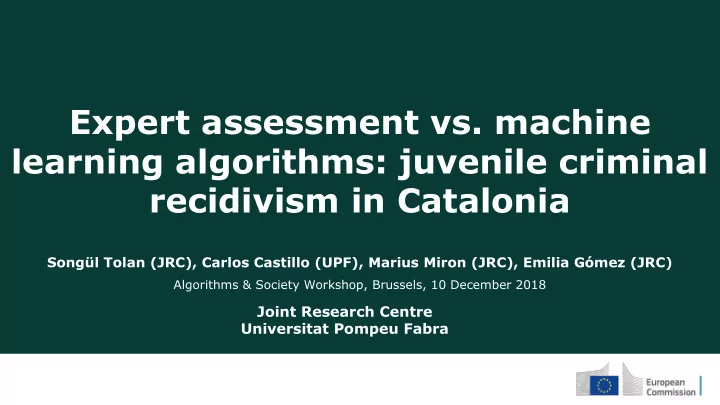

Expert assessment vs. machine learning algorithms: juvenile criminal recidivism in Catalonia Songül Tolan (JRC), Carlos Castillo (UPF), Marius Miron (JRC), Emilia Gómez (JRC) Algorithms & Society Workshop, Brussels, 10 December 2018 Joint Research Centre Universitat Pompeu Fabra
Why use ML methods in criminal justice? • Judge decisions are affected by extraneous factors [Danziger et al., 2011; Chen, 2016] • Algorithms are not affected by cognitive bias • There can be welfare gains: ML flight risk evaluation can yield substantial reductions in crime rate (with no change in jailing rate) or jailing rates (with no increase in crime rates) [Kleinberg et al., 2017]
Why NOT use ML methods in criminal justice? • Machines can inherit human biases through biased data [Barocas and Selbst, 2016] • •In many cases their outputs cannot be explained, so how can we justify? •“They” can be racist •There is a need for “fair” ML
Fairness in ML: the case of COMPAS • ProPublica: COMPAS is unfair! [Angwin et al., 2016] • NorthPointe: COMPAS is fair! Corbett-Davies et al., 2017
Fairness in ML: the case of COMPAS Impossibility proofs: When base rates differ (in Broward County 51% vs. 39%), you cannot achieve calibration and equal FPR/FNR at the same time [Kleinberg et al., 2016; Chouldechova, 2017] Also: ● No single threshold equalizes both FPR and FNR ○ Direct vs. indirect discrimination ● Imposing any fairness criterion has a cost in terms of public safety or defendants incarcerated ● Literature on fairML grows rapidly, but all based on US data Corbett-Davies et al., 2017
What we do • Look at European example: SAVRY in Catalonia • We evaluate SAVRY against ML methods in terms of fairness and predictive performance • We show some evidence that ML methods of risk assessments introduce unfairness and that their use in criminal justice should be fairness-aware
SAVRY • Structured Assessment of Violence Risk in Youth (SAVRY) •Structures Professional Judgement • Also used to assess the risk of (not only violent) crimes upon release •Used to inform decisions on interventions •Sample: Catalonia, 4752 youths aged 12-18, 855 with SAVRY, committed crime between 2002-2010, released in 2010, recidivism by 2015
SAVRY ≠ COMPAS •Detailed and transparent risk assessment •Based on 6 protective factors •Based on 24 risk factors: Historical, Social/Contextual, Individual •We evaluate the sum of 24 risk factors (low, medium, high) against ML methods
Base rates differ
Performance
Performance
Performance
Performance
Performance
Fairness
Fairness
Fairness
Summary and Outline ● ML yields a more precise risk assessment ● When base rates differ, ML methods have to be fairness aware ● Use rich information: ○ for a transparent mitigation of unfairness ○ to adjust features that have a substantial effect on increasing unfairness ○ to refocus analysis away from tensions/tradeoffs towards better targeted interventions ● Further Analysis on human-algorithm interaction: RisCanvi
Thank you! Any questions? You can find me at songul.tolan@ec.europa.eu Find HUMAINT at https://ec.europa.eu/jrc/communities/community/humaint Find Carlos at http://chato.cl/
Recommend
More recommend